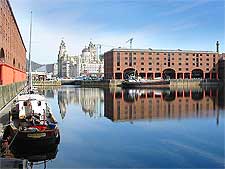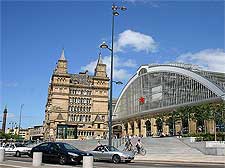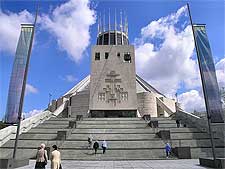Liverpool History Facts and Timeline
(Liverpool, Merseyside, England)

Liverpool has transformed itself from an obscure fishing hamlet to a world-renowned industrial city and port. Its rich history has left an indelible impression on the buildings and people that make up the city today.
There have been many suggestions as to the origin of the city's name. However, it's widely believed that Liverpool simply derives from 'lifer pol' or 'lieurpul', meaning 'muddy pool'. Certainly, the Mersey was called the Pool by the Saxons and Danes who settled there in pre-medieval days.
Early Origins
By the 12th century, there was evidence of a chapel, a tower and a few cottages, although it wasn't until a century later that the potential of Liverpool as a sea port was first recognised. In 1207, King John granted this emerging port the right to hold a weekly market and an annual fair. He also used it as a base for sending troops to Ireland. A castle was built to protect the port. With water on three of its four sides, it must have made an imposing sight. In 1229, Henry III sold Liverpool to its citizens for ten marks. A new Charter was awarded, giving them considerable liberties and the power to form a merchant guild.
Despite these early developments, the city remained largely unchanged up until the 1650s. It's safe to say that life was hard for its citizens back then, with many of them enjoying little in the way of economic prosperity. A number of setbacks during the English Civil War didn't help the situation and economic progress remained slow.

The Rise of a Northern Port
What appears to have been a key event in the history of the city came in 1647, when Liverpool was declared a free port. Henceforth, it didn't have to answer to the Port of Chester.
During the 18th century, living conditions in the city improved considerably. Schools were set up, including a Blue Coat Hospital that provided for boys and girls on a charity basis. Many new streets were laid out and new buildings sprang up.
The construction of a new wet dock in 1715 had dramatic results. This was partly because the port could now take advantage of the growth in the Cheshire salt trade and Lancashire coal pits. Much of Liverpool's wealth was also to come from the increasingly profitable slave trade that operated from here. New stagecoach routes came into operation, opening up the city to the outside world by road. In 1815, the first Mersey Steamer began to ply its trade between Liverpool and Runcorn.
In 1846, the Albert Dock was built. It wasn't long before other wet and dry docks were added and the city became a substantial port, with cargo heading out all over the world. It's thought that the Pier Head was one of the largest floating quays in the world. During the year of 1880, Liverpool was granted city status.

Liverpool in the 20th Century
The dawn of a new century brought the construction of one of the city's most famous buildings, the Royal Liver Building. Its legendary Liver Birds have become symbols of the city.
During World War Two, the city was subjected to a series of air raids, which destroyed thousands of homes. One of Liverpool's most famous citizens, singer John Lennon, was actually born during one of these raids.
After the war, the following stage of history saw the city in a constant state of redevelopment. New housing estates were built, along with new docks. However, a decline in port trade and manufacturing have since taken their toll.
In 1960, it was decided to build a new cathedral. Architects were invited to submit their designs and that of Sir Frederick Gibberd was chosen. In May 1967, the New Anglican Cathedral was consecrated. It has since become one of Liverpool's most iconic landmarks.
 Liverpool has transformed itself from an obscure fishing hamlet to a world-renowned industrial city and port. Its rich history has left an indelible impression on the buildings and people that make up the city today.
Liverpool has transformed itself from an obscure fishing hamlet to a world-renowned industrial city and port. Its rich history has left an indelible impression on the buildings and people that make up the city today.
